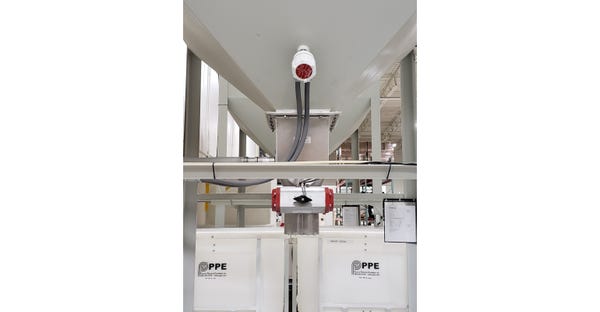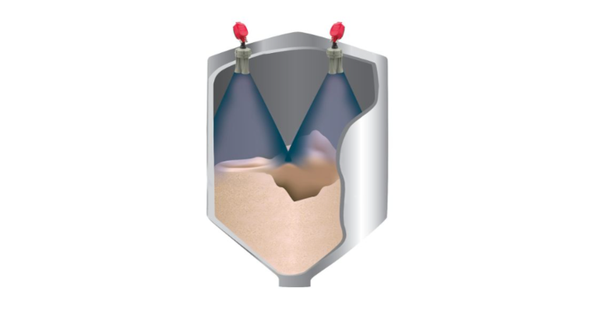Tracking Bulk Solids from Truck to Product
Technology helps Garner Industries guide material process
October 4, 2022

As a 53-foot pneumatic truck brimming with resin pellets arrives at Garner Industries, an automated system was already in place to communicate supply levels to purchasers, process managers, plastic suppliers, and the end customer. Production accounted for material, purchasing received in the delivery, and maintenance met the driver at onsite silos.
This level of planning and coordination requires supply chain precision provided by sensors and software. Itis an ideal example of Industry 4.0.
“All of our tanks, silos, and hoppers are monitored by level sensors,” said Jeff Bolles, Garner Industries purchasing agent. “Before we set this up, getting truck delivery involved a bunch of emails, manual measuring, calls, and crisscross communication. It just opens the possibility of making mistakes. Now, we have multiple people looking at the same report on ResinView. You can’t beat up-to-date data shared instantly with a team.”
Bolles said he also utilizes MultiVision software with 3D material imaging to monitor silo topography, and the Garner injection molding team uses ResinView to monitor material as it moves through pneumatic conveyors to the Garner’s multiple 500-ton presses. Software calculates material to truckloads for easier tracking. Garner uses vibrating rod point level sensors on hoppers, and 3D level sensors on its three large bulk storage silos.

Garner’s system matches Industry 4.0 goals that combine informational and operational technology to make manufacturing more aware, predictive, and autonomous. Employees operating in a 4.0 environment are highly connected with a more complete view of their business ecosystem.
“Ultimately, you want to run autonomously in a closed-loop system where humans set parameters, but technology runs itself,” said Chris Hill, technology program director at Iowa State University Center for Industrial Research and Service. “Sensors and software directly feed an Industry 4.0 environment. They replace a physical process and feed information back to people.”
Inventory Management Technology Transforming
Not long ago, level sensors, with 4-20 mA output, sent measurements to a PLC in the control room. It required plenty of wiring and delivered limited data. In more recent years, inventory software emerged as an alternative to tedious spreadsheets. Software was installed on local area networks and largely managed by IT departments. And now, cloud inventory management is doing away with need for locally installed software. New sensor outputs became vogue, some using Modbus and HART. Graphic interfaces provided more data, automated alerts, and reporting for multiple silo or sites.
Configuring sensors used to be a painstaking process where staff climbed a silo to set parameters for the control room. Today, sensors integrate through web applications, or even Bluetooth and a mobile phone. Sensor setup and level monitoring can happen at the base of a vessel to eliminate climbs up a ladder. Time savings are immediate, and safety assured.
Advanced diagnostics on sensor web apps allow for troubleshooting or monitoring maintenance parameters. Advanced encryption and user access controls boost security and allow only authorized individuals the ability to make changes. “We’ve been following the ResinView software upgrades because the more information we can harness, the better decisions we’ll make” Bolles said “I think the most valuable upgrade, to me, was the text alerts. It sends us level information when we’re getting low. There are so many things to watch now-a-days, that was big.”
Non-Contact Sensors Deliver Accuracy
At one time, non-contact radar level sensors were erratic in dusty conditions typical at many bulk solids processing plants. They lacked power to transmit through dense, airborne particles. Today’s 80 GHz radar technology revolutionized performance of non-contact radar in silos with excessive dust. A focused narrow beam transcends dust and precisely targets a location in the silo to avoid structures and pinpoints a desirable measurement location. Measurements update in a second with accuracy of +/-0.2 in. Radar sensors easily track filling and emptying cycles of processing silos.
Garner employs historical trending to track usage and deliveries then forecast demand. It helps increase inventory turns, reduce safety stock, improve cash flow, increase profitability, and cut lead times. It also can reduce time-consuming meetings, emails, and phone calls, Bolles said.
Maximizing Employee Time with Technology
Large processing plants are big on size and small on staff. No matter where people are located, employees can share data via cloud-based reports. Sensors and software, for example, gather inventory data and prepare it for customer service, purchasing, compliance, production, and enterprise resource planning.
“We’re finding that more and more, large companies have centralized decision-making, especially purchasing and operations,” said Mike Mossage, vice president - regional sales & 3D product specialist for BinMaster. “Supply chain is tight, and staff is scarce, so we’ve built a lot of critical information into our BinCloud-based reporting.”
Sharing data, a team can identify bottlenecks, trends, and opportunities. Even maintenance can use data to facilitate predictive maintenance reducing downtime. History found on cloud reports can help with predictive models and condition-based alerts. Sensor data is used to track equipment, improve work process, streamline supply chains, increase safety, and bring higher overall efficiency.
Customers today expect companies to bring bin, tank, and silo inventory to cell phones,” Mossage said. “People demand mobility. BinCloud inventory software releases new features at almost double the rate of Apple operating systems.”
Vendor Engagement in Managing Inventory
While Garner has streamlined ordering, cumbersome spreadsheets, and inaccurate inventory, last-minute deliveries plague other manufacturers.
Some avoid these issues by allowing vendors to optimize delivery schedules and ensuring plants have the right amount of material in stock.
Vendor managed inventory (VMI) builds a bridge between a plant and its suppliers. It is accomplished by assigning ResinView login credentials and viewing rights, to vendors who monitor inventory in tandem with the plant.
VMI is totally automated and keeps inventory levels up to date 24/7. Vendors take on some responsibility to monitor material. Some vendors could proactively schedule orders, before work stoppages occur. Vendors can perform validation that an entire truckload shipment will fit into the silos without the risk of overfilling.

Remote Monitoring a New Reality
Anywhere, anytime data on demand is possible whether in the office, plant floor, or while making a delivery.
Remote monitoring starts with sensors. Continuous level sensors mount on each silo to measure solid or powdered material. While Garner utilizes non-contact radar, others choose guided wave radar, weight and cable, lasers, ultrasonics, or 3D level scanners to measure inventory levels.
In all cases, sensor data flows seamlessly to a wireless gateway which accepts 4 to 20 and digital inputs, multiple protocols, and updates in two to five seconds.
The gateway instantly sends measurement data to ResinView accessed from a phone or PC. Access is simple. Users log in to a secure app or website and view the easy-to-understand dashboard.
A graphical interface displays inventory levels for each silo. High and low-level alerts can send a text or email when silos are nearly full or empty. Software allows for viewing silos for either a single location or multiple sites. Silos can be sorted by material or alert status.
Wireless Innovations Make a Connected Plant Affordable
Installation costs are a huge consideration. Electricians, power, and wire could more than double the cost of an inventory management system. Today, wireless systems, connect vessels and locations. Many plants are finding they can even upgrade their existing sensors system to a cloud inventory system quite easily using these devices.
Wireless gateways, transceivers, modems, and repeaters have greatly reduced the wiring complexity, requirements, and expense of installation. Long range – or LoRa – antennas allow transmission of data up to a mile line of sight. This eliminates the need for running long spans of wire, making installation far easier even for the largest plants.
A gateway is used to flow data seamlessly from the sensors without extensive wiring for on-site and remote monitoring of silo inventory. Gateways combine the functions of a wireless access point, modem, and a router in one convenient device. They utilize ethernet, Wi-Fi, or cellular connectivity to get data to a PLC, software, or web application. Wiring level sensors together in a daisy chain wiring schematic requires only a single gateway to send data seamlessly from the sensors to the software.
Wireless bridges and gateways are reliable in getting data from point A to point B. They are robust and durable in outdoor environments. At the same time, the price of these devices has come down significantly—finally making a connected plant affordable.
Cloud Inventory Key to Industry 4.0
Supply chain, product demand, and worker shortage all demand the implementation of Industry 4.0 philosophies, which automate time-intensive, manual work to ensure that people are used to their maximum, decision-making capabilities. Moving inventory management from paper, tape measures, and spreadsheets to sensors and custom inventory software provides a great example of Industry 4.0 automation.
For more information, contact BinMaster/Garner Industries (Lincoln, NE) at 402-434-9102 or visit www.binmaster.com.
You May Also Like


